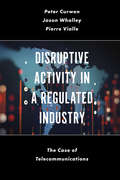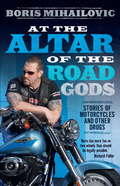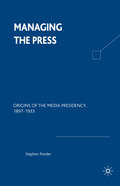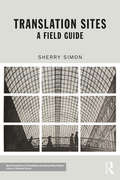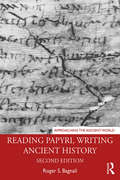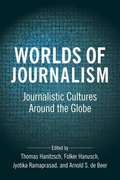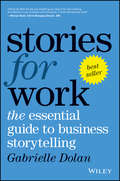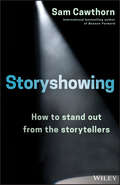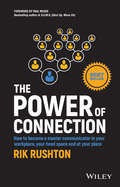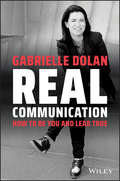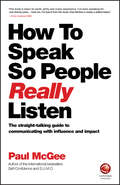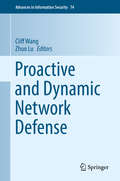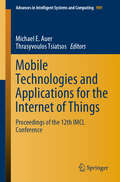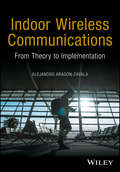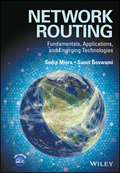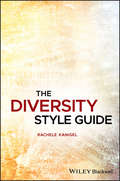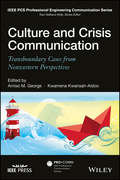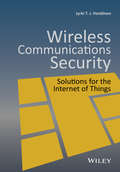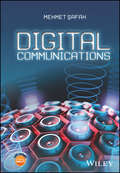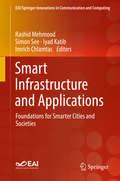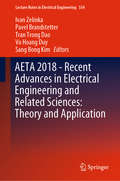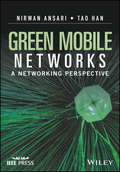- Table View
- List View
Disruptive Activity in a Regulated Industry: The Case of Telecommunications
by Peter Curwen Jason Whalley Pierre VialleTheoretical and empirical work examining disruptive activity within industry has previously been restricted to the free market, even if an element of ad hoc government interference has occurred. In contrast, this book makes a unique evaluation of a situation that prevails across a significant part of the industrial sector where involvement is subject to the acquisition of an operating licence. Taking telecommunications as an illustrative industry, with a particular focus on mobile telecommunications, the book focuses on the regulatory bodies that are tasked with licence issuance. New entry is usually attempted by a single company, often with existing links within the telecommunications sector, and usually within a single country. This book provides detailed accounts of both the individual countries and international operators in question, while also including a case study of CK Hutchinson which has been associated with multiple country entries. It also examines how disruptive activity is evolving from its roots in the mobile sector to encompass so-called “quad-play” which includes fixed-wire broadband and pay-TV. Disruptive Activity in a Regulated Industry: The Case of Telecommunications will appeal to postgraduate researchers and academics in the fields of economics, innovation, regulation, and governance.
At the Altar of the Road Gods: Stories of motorcycles and other drugs
by Boris MihailovicCaution: Contains incidents of insane motorcycle antics, drug use and swearing.'Boris has more fun on two wheels than should be legally possible.' - Richard Fidler, ABCHis mother may not know it but Boris Mihailovic has lived a fast, furious, often politically incorrect life chasing the epiphanies of speed (the sensation not the drug). For Boris, motorbike riding was the rite of passage into manhood he'd been searching for. Now, nearly 40 years since he first rode a bike, the wisdom of age has provided the perspective for Boris to look back and realise some pretty wild shit went down. At the Altar of the Road Gods is about popping your motorcycle-buying cherry with an XJ650 Yamaha. It's about fines, feuds and fractures, high-sides, tank-slappers, angry police, even angrier young men, crashing, getting up, cranky girlfriends, riding faster, outlaws, and partaking in copious amounts of alcohol and drugs. It is about mateship and motorcycles. Ultimately, it is about four decades of two-wheel-related mayhem. Just don't tell Boris's mum! Be warned: may cause laughter, sleeplessness and the desire to buy a Lucifer-black Katana.
Managing the Press: Origins of the Media Presidency, 1897-1933
by NA NAManaging the Press re-examines the emergence of the twentieth century media President, whose authority to govern depends largely on his ability to generate public support by appealing to the citizenry through the news media. From 1897 to 1933, White House successes and failures with the press established a foundation for modern executive leadership and helped to shape patterns of media practices and technologies through which Americans have viewed the presidency during most of the twentieth century. Author Stephen Ponder shows how these findings suggest a new context for contemporary questions about mediated public opinion and the foundations of presidential power, the challenge to the presidency by an increasingly adversarial press, the emergence of 'new media' formats and technologies, and the shaping of presidential leadership for the twenty-first century. Managing the Press explores the rise of the media presidency through the lens of the late-twentieth century, when the relationship between the President and the press is relevant to more important issues than ever before in the context of American politics.
Translation Sites: A Field Guide (New Perspectives in Translation and Interpreting Studies)
by Sherry SimonIn Translation Sites, leading theorist Sherry Simon shows how the processes and effects of translation pervade contemporary life. This field guide is an invitation to explore hotels, markets, museums, checkpoints, gardens, bridges, towers and streets as sites of translation. These are spaces whose meanings are shaped by language traffic and by a clash of memories. Touching on a host of issues from migration to the future of Indigenous cultures, from the politics of architecture to contemporary metrolingualism, Translation Sites powerfully illuminates questions of public interest. Abundantly illustrated, the guidebook creates new connections between translation studies and memory studies, urban geography, architecture and history. This ground-breaking book is both an engaging read for a wide-ranging audience and an important text in broadening the scope of translation studies.
Translation Sites: A Field Guide (New Perspectives in Translation and Interpreting Studies)
by Sherry SimonIn Translation Sites, leading theorist Sherry Simon shows how the processes and effects of translation pervade contemporary life. This field guide is an invitation to explore hotels, markets, museums, checkpoints, gardens, bridges, towers and streets as sites of translation. These are spaces whose meanings are shaped by language traffic and by a clash of memories. Touching on a host of issues from migration to the future of Indigenous cultures, from the politics of architecture to contemporary metrolingualism, Translation Sites powerfully illuminates questions of public interest. Abundantly illustrated, the guidebook creates new connections between translation studies and memory studies, urban geography, architecture and history. This ground-breaking book is both an engaging read for a wide-ranging audience and an important text in broadening the scope of translation studies.
Reading Papyri, Writing Ancient History (Approaching the Ancient World)
by Roger S. BagnallSince its first publication in 1995, Reading Papyri, Writing Ancient History has proved to be an invaluable resource for students of the ancient world looking to integrate papyrological evidence into their research. In the quarter century since its publication, changes in the research environment have affected papyrology like other fields. Although the core philological methods of the field remain in place, the field has increasingly embraced languages other than Greek and Latin, with considerable impact on the Hellenistic and Late Antique periods. Digital tools have increased the ease and speed of access, with profound effects on research choices, and digital imaging and materiality studies have brought questions about the physical form of written materials to the fore. In this fully revised new edition, Bagnall adds to the previous analysis a portrait of how the use of papyri for historical research has developed during recent decades. Updated with the latest research and insights from the author, the volume guides historians in how to use these scattered and often badly damaged documents, and to interpret them in order to create a full and diverse picture of ancient society and culture. This second edition of Reading Papyri, Writing Ancient History continues to offer students and researchers of the ancient world a critical resource in navigating how to use these ancient texts in their research.
Reading Papyri, Writing Ancient History (Approaching the Ancient World)
by Roger S. BagnallSince its first publication in 1995, Reading Papyri, Writing Ancient History has proved to be an invaluable resource for students of the ancient world looking to integrate papyrological evidence into their research. In the quarter century since its publication, changes in the research environment have affected papyrology like other fields. Although the core philological methods of the field remain in place, the field has increasingly embraced languages other than Greek and Latin, with considerable impact on the Hellenistic and Late Antique periods. Digital tools have increased the ease and speed of access, with profound effects on research choices, and digital imaging and materiality studies have brought questions about the physical form of written materials to the fore. In this fully revised new edition, Bagnall adds to the previous analysis a portrait of how the use of papyri for historical research has developed during recent decades. Updated with the latest research and insights from the author, the volume guides historians in how to use these scattered and often badly damaged documents, and to interpret them in order to create a full and diverse picture of ancient society and culture. This second edition of Reading Papyri, Writing Ancient History continues to offer students and researchers of the ancient world a critical resource in navigating how to use these ancient texts in their research.
Worlds of Journalism: Journalistic Cultures Around the Globe (PDF)
by Thomas Hanitzsch Folker Hanusch Jyotika Ramaprasad Arnold BeerHow do journalists around the world view their roles and responsibilities in society? Based on a landmark study that has collected data from more than 27,500 journalists in 67 countries, Worlds of Journalism offers a groundbreaking analysis of the different ways journalists perceive their duties, their relationship to society and government, and the nature and meaning of their work. Challenging assumptions of a universal definition or concept of journalism, the book maps a world populated by a rich diversity of journalistic cultures. Organized around a series of key questions on topics such as editorial autonomy, journalistic ethics, trust in social institutions, and changes in the profession, it details how the practice of journalism differs across the world in a range of political, social, and economic contexts. The book covers how journalism as an institution is created and re-created by journalists and how they experience their profession in very different ways, even as they retain a commitment to some basic, widely shared professional norms and practices. It concludes with a global classification of journalistic cultures that reflects the breadth of worldviews and orientations found in disparate countries and regions. Worlds of Journalism offers an ambitious, comparative global understanding of the state of journalism in a time when it is confronting a series of economic and political threats.
Stories for Work: The Essential Guide to Business Storytelling
by Gabrielle DolanLearn the science and master the art of telling a great story Stories for Work walks you through the science of storytelling, revealing the secrets behind great storytellers and showing you how to master the art of storytelling in business. Stories hold a unique place in our psyche, and the right story at the right time can be a game-changer in business; whether tragedy, triumph, tension or transition, a good story can captivate the listener and help you achieve your goals. In this book, author Gabrielle Dolan draws from a decade of training business leaders in storytelling to show you what works, why it works, when it works best and what never works. You'll learn how to create your own stories — authentically yours, crafted to attain your goal — and develop an instinct for sharing when the time is right. In-depth case studies feature real-world people in real-world businesses, showing how storytelling has changed the way they work, motivate and lead — providing clear examples of the power of this enormously effective skill. Storytelling gives you an edge. Whether you're after a promotion, a difficult client, a big sale or leading through transition, a great story can help you smooth the road and seal the deal. This book is your personal coach for masterful storytelling, with expert guidance and lessons learned from real-world business leaders. Learn why storytelling grabs attention and helps your message get through Master the four types of stories used in business settings Infuse your stories with the personal to highlight your vision and values Craft a selection of stories to pull out at pivotal business moments The oral tradition has ancient roots that unite all humans, and despite our myriad modern distractions, we still respond to a well-told story. Stories for Work helps you put this dynamic to work for you in any business scenario.
Storyshowing: How to Stand Out from the Storytellers
by Sam CawthornTake your audience on a journey to leave a more lasting impact Storyshowing is an instruction manual for making connections. Storytelling has been shown to be one of the most effective methods of persuasion, motivation and inspiration, yet the disconnect remains — you're still only telling. To truly influence people, you need to go deeper than that — you need to show them your story. By inviting your audience in, you connect on a much deeper, more emotional level; you bypass the brain and connect at the root of what it means to be human, leaving a profound impact on their entire outlook. This book shows you how to transcend telling and start showing your story, using an easy-to-follow framework you can start applying today. Unearth your own experiences, and bring your vulnerabilities out into the light; share your emotions and forge a path to true communication. Use images, body language and gestures as tools to build that indelible connection; then and only then will people truly engage and transform their thinking. No matter your message, the impact lies in the delivery. This insightful guide equips you with the tools and skills you need to start communicating like never before. Share more powerful stories using a simple 5-step method Build confidence, influence others and make a deeper connection Be more persuasive in presentations, pitches, calls and talks Transform the way people think by inviting them inside your story The difference between telling and showing is like the difference between a lecture and a play. It's the difference between giving information and taking the audience on a journey. The difference between a brochure and a test drive. Storyshowing helps you level up your communication to leave a lasting, more profound impact.
The Power of Connection: How to Become a Master Communicator in Your Workplace, Your Head Space and at Your Place
by Rik RushtonA simple communication framework to begin practising today We all carry around the technology to stay connected 24/7, yet many of us are disengaged and challenged with our lack of communication skills. The Power of Connection provides you with practical, real-world solutions for improving your professional performance, your personal relationships and your outlook — one conversation at a time. Becoming a confident and compelling communicator might be the most important skill for leaders in the modern business landscape, parents in the modern home and individuals who use ‘self-talk' to help shape their world. By adopting the simple strategies revealed in every chapter, you can become an unshakeable success at what you set out to do. This book is designed to help you start communicating better today, so start reading and start practicing with your very next conversation! Understand your communication strengths and weaknesses Become a better listener to build a deeper connection Learn how communication sits at the heart of all relationships Develop the skills to connect, inspire, engage and empower We are surrounded by noise, yet no one is actually saying anything we can connect with — or are we just not listening? Communication is a two-way street, and involves so much more than just speaking. The Power of Connection offers a quick and easy road map for your personal journey of growth and development that will make you a better parent, friend, spouse and employee. It's the right message for this time considering there's never a wrong time to level up your skills and become more effective at work, at home and in life.
Real Communication: How To Be You and Lead True
by Gabrielle DolanEffective communication through authentic leadership A rapidly evolving workplace and disruptive technologies have created a growing demand for transparency and authenticity in communication from business leaders. Yet many decision-makers find themselves far behind the curve when it comes to understanding and meeting the evolving expectations of employees and customers. Real Communication: How to Be You and Lead True reveals how to guide and communicate in a way that is authentic and will help business leaders truly connect and engage with their teams, customers, and coworkers. • Communicate more effectively • Improve employee engagement • Manage organisational changes • Help teams cope with change When employees trust their leaders, businesses thrive. In Real Communication you will find everything you need to implement new strategies, instill core values, and cultivate engagement.
How to Speak So People Really Listen: The Straight-Talking Guide to Communicating with Influence and Impact
by Paul McGeeLearn how to inspire your audience with best-selling author Paul McGee!13 things you'll discover when reading this book... 1. The big lesson Steve Jobs learnt when an advertising exec threw something at him... and how it will help how you communicate. 2. Seven ways to manage your nerves (surprisingly, you don’t want to eliminate them). 3. Why our obsession with body language is totally wrong, and what to focus on instead. 4. Why you must think about a beachball before you next speak. Believe me, it’s essential. 5. A question your audience is always thinking, and how to ensure you provide the answer. 6. The most common mistake experienced presenters make that nervous ones never do. 7. Why so many presentations cure insomnia, and how to make sure you’re serving an extra strong double espresso instead. 8. The number one thing most presenters forget to bring when they’re speaking to others. 9. Discover the most underprepared part of your presentation, and how to avoid making the same mistake. 10. What women’s magazines and TV soap operas have to teach us about audience engagement. 11. What I learnt from a guy with one of the most powerful memories on the planet, and how it can transform your communication. 12. Discover Tony Blair’s biggest fear when Prime Minister, and how you can tackle the same issue with confidence. 13. Why you don’t have to be funny to use humour in your presentation, and three easy ways to do it.
Proactive and Dynamic Network Defense (Advances in Information Security #74)
by Cliff Wang Zhuo LuThis book discusses and summarizes current research issues, identifies challenges, and outlines future directions for proactive and dynamic network defense. This book also presents the latest fundamental research results toward understanding proactive and dynamic network defense by top researchers in related areas. It includes research results that offer formal frameworks to define proactive and dynamic network defense, and develop novel models to analyze and evaluate proactive designs and strategies in computer systems, network systems, cyber-physical systems and wireless networks. A wide variety of scientific techniques have been highlighted to study these problems in the fundamental domain. As the convergence of our physical and digital worlds grows fast pace, protecting information systems from being tampered or unauthorized access is becoming one of the most importance issues. The traditional mechanisms of network defense are built upon a static, passive, and reactive nature, which has insufficient to defend against today's attackers that attempt to persistently analyze, probe, circumvent or fool such mechanisms. It has not yet been fully investigated to address the early stage of “cyber kill chain” when adversaries carry out sophisticated reconnaissance to plan attacks against a defense system. Recently, proactive and dynamic network defense has been proposed as an important alternative towards comprehensive network defense. Two representative types of such defense are moving target defense (MTD) and deception-based techniques. These emerging approaches show great promise to proactively disrupt the cyber-attack kill chain and are increasingly gaining interest within both academia and industry. However, these approaches are still in their preliminary design stage. Despite the promising potential, there are research issues yet to be solved regarding the effectiveness, efficiency, costs and usability of such approaches. In addition, it is also necessary to identify future research directions and challenges, which is an essential step towards fully embracing proactive and dynamic network defense. This book will serve as a great introduction for advanced-level computer science and engineering students who would like to start R&D efforts in the field of proactive and dynamic network defense. Researchers and professionals who work in this related field will also find this book useful as a reference.
Mobile Technologies and Applications for the Internet of Things: Proceedings of the 12th IMCL Conference (Advances in Intelligent Systems and Computing #909)
by Michael E. Auer Thrasyvoulos TsiatsosThis book discusses and assesses the latest trends in the interactive mobile field, and presents the outcomes of the 12th International Conference on Interactive Mobile Communication Technologies and Learning (IMCL2018), which was held in Hamilton, Canada on October 11 and 12, 2018. Today, interactive mobile technologies are at the core of many – if not all – fields of society. Not only does the younger generation of students expect a mobile working and learning environment, but also the new ideas, technologies and solutions coming out practically every day are further strengthening this trend. Since its inception in 2006, the conference has been devoted to highlighting new approaches in interactive mobile technologies with a focus on learning. The IMCL conferences have since established themselves as a valuable forum for exchanging and discussing new research results and relevant trends, as well as practical experience and best-practice examples. This book contains papers in the fields of: Interactive Collaborative Mobile Learning Environments Mobile Health Care Training Game-based Learning Design of Internet of Things (IoT) Devices and Applications Assessment and Quality in Mobile Learning. Its potential readership includes policymakers, educators and researchers in pedagogy and learning theory, schoolteachers, the learning industry, further education lecturers, etc.
Indoor Wireless Communications: From Theory to Implementation
by Alejandro Aragón-ZavalaIndoor Wireless Communications: From Theory to Implementation provides an in-depth reference for design engineers, system planners and post graduate students interested in the vastly popular field of indoor wireless communications. It contains wireless applications and services for in-building scenarios and knowledge of key elements in the design and implementation of these systems. Technologies such as Wireless Local Area Networks, Bluetooth, ZigBee, Indoor Optical Communications, WiMAX, UMTS and GSM for indoor environments are fully explained and illustrated with examples. Antennas and propagation issues for in-building scenarios are also discussed, emphasizing models and antenna types specifically developed for indoor communications. An exhaustive survey on indoor wireless communication equipment is also presented, covering all available technologies including antennas, distribution systems, transceivers and base stations.
Network Routing: Fundamentals, Applications, and Emerging Technologies
by Sudip Misra Sumit GoswamiNetwork Routing: Fundamentals, Applications and Emerging Technologies serves as single point of reference for both advanced undergraduate and graduate students studying network routing, covering both the fundamental and more moderately advanced concepts of routing in traditional data networks such as the Internet, and emerging routing concepts currently being researched and developed, such as cellular networks, wireless ad hoc networks, sensor networks, and low power networks.
The Diversity Style Guide: A Journalist′s Handbook
by Rachele KanigelNew diversity style guide helps journalists write with authority and accuracy about a complex, multicultural world A companion to the online resource of the same name, The Diversity Style Guide raises the consciousness of journalists who strive to be accurate. Based on studies, news reports and style guides, as well as interviews with more than 50 journalists and experts, it offers the best, most up-to-date advice on writing about underrepresented and often misrepresented groups. Addressing such thorny questions as whether the words Black and White should be capitalized when referring to race and which pronouns to use for people who don't identify as male or female, the book helps readers navigate the minefield of names, terms, labels and colloquialisms that come with living in a diverse society. The Diversity Style Guide comes in two parts. Part One offers enlightening chapters on Why is Diversity So Important; Implicit Bias; Black Americans; Native People; Hispanics and Latinos; Asian Americans and Pacific Islanders; Arab Americans and Muslim Americans; Immigrants and Immigration; Gender Identity and Sexual Orientation; People with Disabilities; Gender Equality in the News Media; Mental Illness, Substance Abuse and Suicide; and Diversity and Inclusion in a Changing Industry. Part Two includes Diversity and Inclusion Activities and an A-Z Guide with more than 500 terms. This guide: Helps journalists, journalism students, and other media writers better understand the context behind hot-button words so they can report with confidence and sensitivity Explores the subtle and not-so-subtle ways that certain words can alienate a source or infuriate a reader Provides writers with an understanding that diversity in journalism is about accuracy and truth, not "political correctness." Brings together guidance from more than 20 organizations and style guides into a single handy reference book The Diversity Style Guide is first and foremost a guide for journalists, but it is also an important resource for journalism and writing instructors, as well as other media professionals. In addition, it will appeal to those in other fields looking to make informed choices in their word usage and their personal interactions.
Worlds Of Journalism: Journalistic Cultures Around The Globe (PDF)
by Thomas Hanitzsch Folker Hanusch Jyotika Ramaprasad Arnold BeerHow do journalists around the world view their roles and responsibilities in society? Based on a landmark study that has collected data from more than 27,500 journalists in 67 countries, Worlds of Journalism offers a groundbreaking analysis of the different ways journalists perceive their duties, their relationship to society and government, and the nature and meaning of their work. Challenging assumptions of a universal definition or concept of journalism, the book maps a world populated by a rich diversity of journalistic cultures. Organized around a series of key questions on topics such as editorial autonomy, journalistic ethics, trust in social institutions, and changes in the profession, it details how the practice of journalism differs across the world in a range of political, social, and economic contexts. The book covers how journalism as an institution is created and re-created by journalists and how they experience their profession in very different ways, even as they retain a commitment to some basic, widely shared professional norms and practices. It concludes with a global classification of journalistic cultures that reflects the breadth of worldviews and orientations found in disparate countries and regions. Worlds of Journalism offers an ambitious, comparative global understanding of the state of journalism in a time when it is confronting a series of economic and political threats.
Culture and Crisis Communication: Transboundary Cases from Nonwestern Perspectives (IEEE PCS Professional Engineering Communication Series)
by Amiso M. George Kwamena Kwansah-AidooA collection of case studies from nonwestern countries that offers an analysis of the significant role culture plays in crisis communication Culture and Crisis Communication presents an examination of how politics, culture, religion, and other social issues affect crisis communication and management in nonwestern countries. From intense human tragedy to the follies of the rich, the chapters examine how companies, organizations, news outlets, health organizations, technical experts, politicians, and local communities communicate in crisis situations. Taking a wider view than a single country’s perspective, the text contains a cross-cultural and cross-country approach. In addition, the case studies offer valuable lessons that organizations that wish to operate or are operating in those cultures can adopt in preparing and managing crises. The book highlights recent crisis events such as Syria’s civil war, missing Malaysia Flight MH370, andJapan’s Fukushima Daiichi nuclear power plant disaster. Each of the case studies examines how culture impacts communication and responses to crises. Authoritative, insightful, and instructive, this important resource: Analyzes how nonwestern cultures respond to crises Covers the role of culture in crisis communication in recent news events Includes contributions from 18 international authors who provide insight on nonwestern culture and crisis communication Written for communication professionals, academics, and students, Culture and Crisis Communication presents an insightful introduction to the topic of culture and crisis communication and then delves into illustrative case studies that explore intra-cultural and trans-boundary crisis communication.
Wireless Communications Security: Solutions for the Internet of Things
by Jyrki T. PenttinenThis book describes the current and most probable future wireless security solutions. The focus is on the technical discussion of existing systems and new trends like Internet of Things (IoT). It also discusses existing and potential security threats, presents methods for protecting systems, operators and end-users, describes security systems attack types and the new dangers in the ever-evolving Internet. The book functions as a practical guide describing the evolvement of the wireless environment, and how to ensure the fluent continuum of the new functionalities, whilst minimizing the potential risks in network security.
Digital Communications
by Mehmet SafakThis is a modern textbook on digital communications and is designed for senior undergraduate and graduate students, whilst also providing a valuable reference for those working in the telecommunications industry. It provides a simple and thorough access to a wide range of topics through use of figures, tables, examples and problem sets. The author provides an integrated approach between RF engineering and statistical theory of communications. Intuitive explanations of the theoretical and practical aspects of telecommunications help the reader to acquire a deeper understanding of the topics. The book covers the fundamentals of antennas, channel modelling, receiver system noise, A/D conversion of signals, PCM, baseband transmission, optimum receiver, modulation techniques, error control coding, OFDM, fading channels, diversity and combining techniques, MIMO systems and cooperative communications. It will be an essential reference for all students and practitioners in the electrical engineering field.
Smart Infrastructure and Applications: Foundations for Smarter Cities and Societies (EAI/Springer Innovations in Communication and Computing #224)
by Rashid Mehmood Simon See Iyad Katib Imrich ChlamtacThis book provides a multidisciplinary view of smart infrastructure through a range of diverse introductory and advanced topics. The book features an array of subjects that include: smart cities and infrastructure, e-healthcare, emergency and disaster management, Internet of Vehicles, supply chain management, eGovernance, and high performance computing. The book is divided into five parts: Smart Transportation, Smart Healthcare, Miscellaneous Applications, Big Data and High Performance Computing, and Internet of Things (IoT). Contributions are from academics, researchers, and industry professionals around the world. Features a broad mix of topics related to smart infrastructure and smart applications, particularly high performance computing, big data, and artificial intelligence; Includes a strong emphasis on methodological aspects of infrastructure, technology and application development; Presents a substantial overview of research and development on key economic sectors including healthcare and transportation.
AETA 2018 - Recent Advances in Electrical Engineering and Related Sciences: Theory and Application (Lecture Notes in Electrical Engineering #554)
by Ivan Zelinka Pavel Brandstetter Tran Trong Dao Vo Hoang Duy Sang Bong KimThese proceedings address a broad range of topic areas, including telecommunication, power systems, digital signal processing, robotics, control systems, renewable energy, power electronics, soft computing and more. Today’s world is based on vitally important technologies that combine e.g. electronics, cybernetics, computer science, telecommunication, and physics. However, since the advent of these technologies, we have been confronted with numerous technological challenges such as finding optimal solutions to various problems regarding controlling technologies, signal processing, power source design, robotics, etc. Readers will find papers on these and other topics, which share fresh ideas and provide state-of-the-art overviews. They will also benefit practitioners, who can easily apply the issues discussed here to solve real-life problems in their own work. Accordingly, the proceedings offer a valuable resource for all scientists and engineers pursuing research and applications in the above-mentioned fields.
Green Mobile Networks: A Networking Perspective (Wiley - IEEE)
by Nirwan Ansari Tao HanGreen communications is a very hot topic. As mobile networks evolve in terms of higher rates/throughput, a consequent impact on operating costs is due to (aggregate) network energy consumption. As such, design on 4G networks and beyond have increasingly started to focus on `energy efficiency’ or so-called ‘green’ networks. Many techniques and solutions have been proposed to enhance the energy efficiency of mobile networks, yet no book has provided an in-depth analysis of the energy consumption issues in mobile networks nor has detailed theories, tools and solutions for solving the energy efficiency problems. This book presents the techniques and solutions for enhancing energy efficiency of future mobile networks, and consists of three major parts. The first part presents a general description of mobile network evolution in terms of both capacity and energy efficiency. The second part discusses the advanced techniques to green mobile networks. The third part discusses the solutions that enhance mobile network energy efficiency as well as provides future directions. Whilst the reader is expected to have basic knowledge of wireless communications, the authors present a brief introduction of the evolution of mobile networks, providing the knowledge base for understanding the content of the book. In addition, complicated network problems are illustrated using simple examples. This will help the reader understand the concept and intuition of various techniques and solutions. Incorporates the latest research results from both academia and industry, providing an up-to-date overview of existing technologies and solutions on making mobile networks greener Consists of three sections with a gradually increasing technical depth on green mobile networks, providing the reader with a systematic view of the research area, and helping those with different technical backgrounds to better understand the content Covers existing enabling technologies for green mobile networking, including an innovative discussion of state-of-the-art solutions and algorithms
